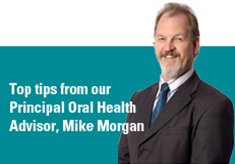May 27, 2012
How does tooth whitening work?
Tooth whitening attempts to make teeth appear ‘paper-white’ by bleaching the enamel surface of the tooth. Adult teeth are not naturally ‘paper-white’ - they are commonly described as naturally ‘pearly white’.
| |

Professor Mike Morgan is the Executive Director of Oral Health Leadership at
Dental Health Services Victoria. Mike is also a dentist and holds the Colgate Chair of Population Oral Health at The University of Melbourne.
|
Tooth colour is mostly determined by the dentine inside the tooth, which is yellow. With age, adult teeth can become darker due to the gradual thinning of enamel, allowing the dentine colour to show through.
|
Keep in mind:
- Whitening is usually performed by applying a high concentration of oxidizing agent (usually peroxide) to the teeth.
- Results can vary from very positive to almost non-existent depending on the original tooth colour, the cause of colour irregularities on the enamel surface, and the whitening technique used.
- Teeth and gums should be checked for disease by a dentist before undergoing any whitening.
- Stains on the teeth caused by food, smoking and bacterial pigments can usually be minimised and even removed without tooth whitening, for example:
- Limit intake of food and drinks (tea, coffee) that stain and if you are a smoker, try to quit.
- Regular, proper brushing with fluoride toothpaste.
- Regular dental check-ups with scaling and polishing (particularly for smoking stains).
- Frequent application of tooth whitening chemicals can permanently damage the enamel surface and the soft gum tissues.
|
Please note: Dental Health Services Victoria recommends that you seek advice from your oral health professional before whitening your teeth.
Related information:
Read more from Professor Mike Morgan on tooth whitening
Food and drink for maintaining healthy teeth
Teeth tips and facts